Ecology & Zoology

Body hair in mammals is typically thought to have evolved to keep us warm in colder prehistoric periods but in elephants it may do the opposite. A new study contends epidermal hair may have evolved to help the animals keep cool in the hot regions they live in.
Low surface densities of hair can help dissipate heat but the biological and evolutionary significance of sparse skin hair is not well known. The authors of the new paper studied the effects of skin hair densities in Asian and African elephants on thermoregulation in these animals, and concluded that elephant skin hair…
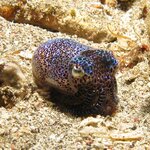
To celebrate International Cephalopod Awareness Days, I decided to comb through all the cephalopod news since last October (and there's been quite a bit of it) to bring you the top ten essential, not-to-be missed stories of cephalopod science and culture. The theme of 2012 seems to have been the discovery of unexpected and slightly embarrassing habits . . .
1. The vampire squid from hell, for example, was caught with globs of mucus and feces in its mouth--destroying its fearsome image as terror of the deep (which was already belied by its huge blue eyes). Proceedings of the…

Seven species of vulnerable sharks and manta rays have now been submitted by 35 countries for consideration for protection next year under an international treaty concerned with regulating wildlife trade.
Governments met the deadline today and formally submitted their proposals for the meeting of the Convention on International Trade in Endangered Species of Wild Fauna and Flora (CITES) in March 2013. The recommendations include porbeagle and oceanic whitetip sharks, three species of hammerhead sharks, and two types of manta rays. For nearly 40 years, CITES has shielded thousands of plants…

In India most of the marine mammal records come from stranding and accidental catch in trawls and purse seine. There are two main habitat of marine mammals in India, (1) Arabian Sea on the western coast with a wide continental shelf and constant salinity, and (2) Bay of Bengal with narrow continental shelf and fluctuating salinity. Both the habitats provide optimum living condition for tropical marine mammals as there are few Islands and submarine features which offers less hindrance in their movement. Arabian sea is rich in bio- resource and offers enormous food (most…
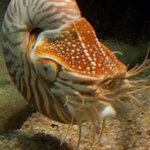
A couple of weeks ago ago, a debate about the existence of scavenging cephalopods broke out on the cephalopod mailing list. A few days later, such a creature appeared in the news as if conjured!
A grad student had e-mailed the ceph-list because he’d found a website that claimed “most cephalopods are active hunters while some are scavengers.” He couldn’t think of any scavenging cephalopods, and wanted to know if anyone else could.
The list’s eclectic mix of scientists, professional aquarists, and hobbyists was quick to respond. Our general conclusion was that most octopuses will eat freshly…

Thinking of some amazing organisms in a sandy beach, the sand bubbler crab always comes in mind. Dotilla clepsydrodactylus, the sand bubbler crab, is the one crab which makes the beaches more beautiful by displaying its marvelous art.
While walking on beaches in Andaman Islands, India, during low tide we can savor the beautiful designs done by these crabs. So, why and how these crabs design like this? The answer is: food!! These crabs have no idea that they are making beautiful designs for us. They are so ignorant that they design pretty well!.
The sand…
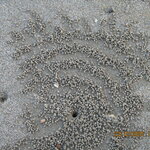
I had one of a kind experience when I went to a very beautiful beach in south Andaman. The whole beach was populated with the sand crabs, Ocipode quadrata, the ghost crab, Dotilla myctiroides , soldier crab and the most important Dotilla clepsydrodactylus, the sand crab. The sandy beach is the only habitat these crabs are comfortable as they pop in and pop out of their burrow in every low and high tide respectively, which make them the perfect organism to sense the rise and fall of the tide. I was in Andamans for two years from July 2006 to May 2008, where I did…
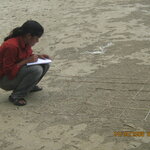
I had one of a kind experience when I went to a very beautiful beach in south Andaman. The whole beach was populated with the sand crabs, Ocipode quadrata, the ghost crab, Dotilla myctiroides , soldier crab and the most important Dotilla clepsydrodactylus, the sand crab. The sandy beach is the only habitat these crabs are comfortable as they pop in and pop out of their burrow in every low and high tide respectively, which make them the perfect organism to sense the rise and fall of the tide. I was in Andamans for two years from July 2006 to May 2008, where I did M. Sc. inn Marine…

While organic farmers like to claim the boom in agriculture of the last 30 years was not related to science, history says otherwise.
A pest that pre-science farming could never conquer has returned to torment the modern organic kind. While conventional pesticides, which were created to defeat pests and blight a laissez faire approach to growing could not, kill Orchestes pallicornis, the apple flea weevil, just fine, things are not looking good for organic apple orchards in Michigan, where outbreak population levels have been observed since 2008, and damage has resulted in up to 90…
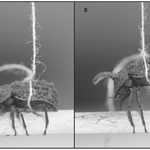
Combat traits usually get most of the attention from researchers, because they are thought to have arisen due to intense male-male competition for access to females. Large, elaborate weapons become the focus of sexual selection studies because the connection is obvious. Collared lizards (Crotaphytus collaris), for example, have bite force correlated with head width, and it positively predicts the number of offspring produced in a breeding season, suggesting sexual selection on head morphology and the role of attacking traits.
But maybe defense wins sex games too. Sexual selection in the…